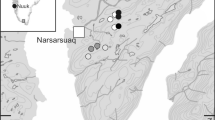Summary
Four heathland spider species, Agroeca proxima, Centromerita concinna, Theridion simile, and Philodromus histrio, were studied in the Kalmthout National Nature Reserve in northern Belgium. They were caught by pitfall trapping or sweeping in different Calluna heath plots where the vegetation was in varying stages of development after being burnt, mowed, or grazed. Each species proved to thrive in a different plot, its numbers being greater and its size larger (cephalothorax width) in that plot. For the first two species positive correlations were found, for males as well as for females, between average size and numbers caught during a complete year cycle in a particular habitat.
In contrast to non-predators, which are smaller when their populations are denser, spiders show a functional response that explains their increase in size with increasing density. It is suggested that in this respect a fundamental difference exists between predators and non-predators.
Similar content being viewed by others
References
Anderson JF (1974) Responses to starvation in the spiders Lycosa lenta Hentz and Filistata hibernalis (Hentz). Ecology 55:576–585
Benforado J, Kistler KH (1973) Growth of the orb weaver Araneus diadematus and correlation with web measurements. Psyche 79:90–100
Colebourn PH (1974) The influence of habitat structure on the distribution of Araneus diadematus (Clerck). J Anim Ecol 43:401–409
Enright JT (1976) Climate and population regulation. Oecologia (Berl) 24:295–310
Greenstone MH (1978) The numerical response to prey availability of Pardosa ramulosa (McCook) (Araneae: Lycosidae) and its relationship to the role of spiders in the balance of nature. Symp Zool Soc London 42:183–193
Holmes JC (1961) Effects of concurrent infections on Hymenolepis diminuta (Cestoda) and Moniliformis dubius (Acanthocephala). I: General effects and comparison with crowding. J Parasitol 47:209–216
Holmes JC (1962) II: Effects on growth. J Parasitol 48:87–96
Jocque R (1977) Une étude sur Clarias senegalensis dans la région du Lac Kossou (Côte d'Ivoire). Hydrobiologia 54:49–65
Kajak A (1967) Productivity of some populations of web spiders. In: K Petrusewicz (ed), Secondary productivity in terrestrial ecosystems. Warszawa-Krakow pp 807–820
Kajak A (1978) Analysis of consumption by spiders under laboratory and field conditions. Ekol Polska 26:409–427
Kajak A, Stejgwillo-Laudanska B (1968) Amount and availability of food and consumption of a predator (Araneus quadratus Clerk) under different ecological conditions. Ekol Polska B 14:282–286
Kessler A (1973a) A comparative study of the production of eggs in eight Pardosa species in the field (Araneida, Lycosidae). Tijdschr Entomol 116:1–4
Kessler A (1973b) Een vergelijkend onderzoek naar eiproductie en nataliteit bij wolfspinnen van het genus Pardosa (Aranea, Lycosidae). PhD thesis, unpublished
Kessler A, Slings R (1980) Microhabitat selection in adults and juveniles of Pardosa purbeckensis FOP-Cambridge (Araneae, Lycosidae). Verh 8 Int Arachnol Kongr, Verlag Egerman, Wien, pp 151–154
Krzyzanowska E (1979) Field experiments on the filling of space with the community of Araneus diadematus (Clerck) (Aranei) in a pine stand. Memorabilia Zool 30:27–35
Merrett P (1976) Changes in the ground-living spider fauna after heathland fires in Dorset. Bull Br Arachnol Soc 3:214–221
Miyashita K (1968) Growth and development of Lycosa t-insignita Boes and Str (Araneae: Lycosidae) under different feeding conditions. Appl Entomol Zool 3:81–88
Mooy-Vogelaer JW, Jager JC, Vandersteen WJ (1970) The effect of density changes on the reproduction of the pond snail Lymnaea stagnalis (L.). Neth J Zool 20:279–288
Murdoch WW (1971) The developmental response of predators to changes in prey density. Ecology 52:132–137
Oosterhoff L (1977) Variation in growth rate as an ecological factor in the land snail Cepaea nemoralis (L). Neth J Zool 37:1–132
Riechert SE (1974a) Thoughts on the ecological significance of spiders. Bioscience 24:352–386
Riechert SE (1974b) The pattern of local web distribution in a desert spider: mechanisms and seasonal distribution. J Anim Ecol 43:733–746
Riechert SE, Tracy CR (1975) A model relating web-site characteristics to spider reproductive success in a desert spider Agelenopsis aperta (Gertsch). (Ar Agel) Ecology 56:265–284
Schaefer M (1978) Some experiments on the regulation of population density in the spider Floronia bucculenta (Araneida: Linyphiidae). Symp Zool Soc London 42:203–210
Schauermann J (1976) Zur Abundanz und Biomassendynamik der Tiere in Büchenwalder der Solling. Verh Ges Ökologie pp 113–124
Toft S (1980) Body size relations of sheet-web spiders in Danish Calluna heaths. Verh 8. Int Arachnol Kongr. Verlag Egermann, Wien pp 161–164
Turnbull AL (1965) Effects of prey abundance on the development of the spider Agelenopsis potteri (Blackwall) (Araneae: Agelenidae). Ann Ent 97:141–147
Turnbull AL (1973) Ecology of the true spiders (Araneomorphae). Ann Rev Ent 18:305–346
Way MJ, Cammell ME (1971) Self-regulation in aphid populations. Proc adv study int dynamics numbers popul (Oosterbeek, 1970): 232–242
Wise DH (1979) Effects of an experimental increase in prey abundance upon the reproductive rates of two orb-weaving spider species (Araneae: Araneidae). Oecologia (Berl) 41:289–300
Wolda H (1969) Fine distribution of morph frequencies in the snail Cepaea nemoralis near Groningen. J Anim Ecol 38:305–327
Wonnacott TH, Wonnacott RJ (1972) Introductory statistics. Wiley and Sons, New York, pp 510
Author information
Authors and Affiliations
Rights and permissions
About this article
Cite this article
Jocqué, R. On reduced size in spiders from marginal habitats. Oecologia 49, 404–408 (1981). https://doi.org/10.1007/BF00347607
Received:
Issue Date:
DOI: https://doi.org/10.1007/BF00347607




